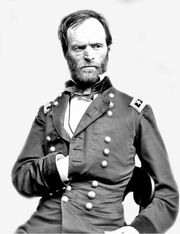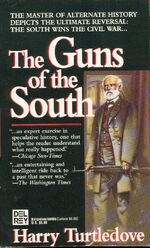| ||||||||||||||||||||||||||||||||
William Tecumseh Sherman (February 20, 1820 – February 14, 1891) was an American soldier, businessman, educator, and author. He served as a General in the U.S. Army during the American Civil War (1861–5), for which he received recognition for his outstanding command of military strategy as well as criticism for the harshness of the "scorched earth" policies that he implemented in conducting total war against the South, most notoriously in the March Through Georgia.
After the Civil War, Sherman was promoted to Commanding General of the United States Army and oversaw the country's various Indian Wars. He also published his memoirs.
William Sherman in The Guns of the South[]
General William Sherman's advance into the heart of the Confederacy was completely halted by General Joseph Johnston, whose Army of Tennessee was re-armed with AK-47s as the winter of 1863-1864 drew to a close. During the 1864 campaign, Sherman's forces met Johnston's at Rocky Face Ridge, and then again at Resaca and Snake Creek Gap.
With each of those battles, Sherman gained more ground in Georgia but suffered ruinous casualties. After the third battle, he stopped all attempts at advancing, fearful of the Confederate firepower. Sherman's gains were the only ones made by the Union in the short 1864 Campaign.
Concurrent to his offensives against the Army of Tennessee, Sherman had ordered his subordinate General Sturgis to lead a force down into Mississippi against Nathan Bedford Forrest's cavalry force, which Sherman feared could advance all the way into Tennessee and threaten his army's supply lines. Sturgis suffered a crippling defeat at the hands of the AK-47s just like Sherman, and Forrest advanced close to Memphis, where he'd be able to do just as Sherman feared.
After the Army of Northern Virginia took Washington City, General Robert E. Lee used Sherman's precarious situation to convince President Lincoln that he had no hope of salvaging the Union's fortunes in the war and that it would be better to spare the lives of his men. Lincoln agreed to an armistices, and ordered Sherman and his forces to return to the United States. Before the withdrawal could be completed, Forrest violated the armistices and destroyed the rail lines in Tennessee anyway. Starving, Sherman and his forces returned home in humiliated defeat.
William Sherman in Southern Victory[]
| Southern Victory POD: September 10, 1862 | |
| Appearance(s): | How Few Remain |
| Type of Appearance: | Direct |
| Military Branch: | US Army (War of Secession Second Mexican War) |
When the War of Secession began in 1861, William Sherman was promoted to the rank of Colonel in the regular army and participated in the First Battle of Bull Run, where he fought with distinction and received a promotion to Brigadier General of Volunteers. Unfortunately, not long afterwards, Sherman suffered a breakdown, an event that would later haunt his military career. Although he fought with valor at Shiloh, and received a promotion to Brevet Major General, it came to naught when the Union was defeated at Camp Hill, and forced by Great Britain and France to recognize the Confederacy. In the years following, Sherman was stripped of his brevet rank and was returned to colonel. Haunted by lingering rumors of insanity, he would never receive a generalship of regular troops.
Nonetheless, Sherman remained in the US Army and by 1881, he commanded the defenses of San Francisco from his headquarters at the Presidio. When the Second Mexican War began later that year, Sherman organized volunteers and harbor guns in preparation for any attacks. His efforts were mocked greatly by anti-war journalist and Confederate veteran Samuel Clemens of The Morning Call. Because of this, he interviewed Clemens on suspicion that he was a Confederate agent, but found nothing to substantiate it and gave Clemens a letter to that effect.
As the war dragged on, the Royal Navy turned up the pressure against the United States and raided San Francisco. In spite of Sherman's preparations, the harbor guns were Infective and his own troops proved inadequate in stopping the Royal Marines from raiding the US Mint.
After the British raid on San Francisco, Sherman was greatly embarrassed and ridiculed in the city's papers, especially the Morning Call. However, after the cease fire was called, Sherman loudly insisted that with more fortifications, he could make the city impregnable. Although he never received his request, he took matters into his own hands, bringing in many more guns to defend the city. Although all of these were small-caliber field pieces, which weren't a match for the RN's big guns, they had the twin advantages of being common and mobile.
Upon hearing this, Samuel Clemens couldn't help but acknowledge that Sherman was making an effort compared to most US generals and politicians.
See Also[]
- References to Historical Figures in Turtledove's Work for more minor references to Sherman.
- Hesmucet, a fantasy analog of William Sherman in The War Between the Provinces series.
References[]
| Military offices (OTL) | ||
|---|---|---|
| Preceded by Ulysses S. Grant |
Commanding General of the United States Army 1869–1883 |
Succeeded by Philip Sheridan |
| ||||||||
| |||||||||||||||||||












